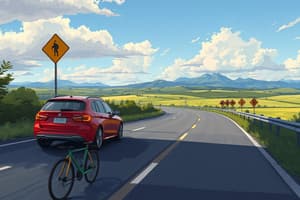Podcast
Questions and Answers
What is the recommended time frame for scanning ahead while riding in order to prepare for potential hazards?
What is the recommended time frame for scanning ahead while riding in order to prepare for potential hazards?
- 6 to 9 seconds
- 8 to 12 seconds (correct)
- 12 to 15 seconds
- 10 to 15 seconds
Which action should be prioritized when approaching an intersection?
Which action should be prioritized when approaching an intersection?
- Making a left turn without checking for cyclists
- Ignoring pedestrians and focusing solely on vehicles
- Performing a shoulder check before moving forward (correct)
- Accelerating to clear the intersection quickly
When riding along a residential road and encountering a driver who seems uncertain, what is the best practice?
When riding along a residential road and encountering a driver who seems uncertain, what is the best practice?
- Maintain a constant speed and ignore the driver
- Stop and wait for the driver to make a decision
- Accelerate quickly to get away from the vehicle
- Scan the area for potential hazards without changing your speed (correct)
What does it mean to 'think like a rider' in the context of collision prevention?
What does it mean to 'think like a rider' in the context of collision prevention?
Why is it essential to scan to the left and right while riding?
Why is it essential to scan to the left and right while riding?
Which technique is emphasized for ensuring road safety while riding?
Which technique is emphasized for ensuring road safety while riding?
Why is peripheral vision important for riders?
Why is peripheral vision important for riders?
What should riders consider regarding road conditions?
What should riders consider regarding road conditions?
In terms of environmental scanning, what is a key practice for riders?
In terms of environmental scanning, what is a key practice for riders?
What is a critical factor in preventing collisions while riding?
What is a critical factor in preventing collisions while riding?
Flashcards are hidden until you start studying
Study Notes
Intersection Procedures
- Stop and edge forward into the intersection to enhance visibility before proceeding.
- Complete the observation cycle every five to eight seconds when navigating intersections.
Turning Safely
- Perform a shoulder check to ensure no cyclists or other road users are alongside before turning.
- Scan the intersection prior to movement and focus eyes in the intended direction during the turn.
Hazard Awareness
- Maintain awareness by scanning at least 12 seconds ahead while riding.
- In urban environments, look one to two blocks ahead; on highways, extend this distance to half a kilometer.
- 65% of motorcycle crashes involve multiple vehicles, with an 80% occurrence rate due to actions of other drivers.
Scanning and Peripheral Vision
- Keep eyes moving and scan left, right, and ahead for potential hazards.
- Use peripheral vision to detect road users, conditions, and activities, expanding awareness beyond central vision.
Environmental Awareness
- Assess weather conditions and ensure appropriate gear is worn for safety while riding.
- Predict potential hazards by observing elements in your environment like traffic signals and nearby vehicles.
Predictive Riding
- Anticipate changes in the riding environment, such as traffic light changes and driver behaviors.
- Consider potential scenarios such as the timing of a yellow light and personal riding decisions based on speed and surroundings.
Decision-Making in Traffic
- It's essential to evaluate the situation at congested intersections, analyzing gaps for safe turning opportunities.
- Weigh the choice between waiting for a safe turn or the pressure to act quickly due to impatience from drivers behind.
Studying That Suits You
Use AI to generate personalized quizzes and flashcards to suit your learning preferences.




